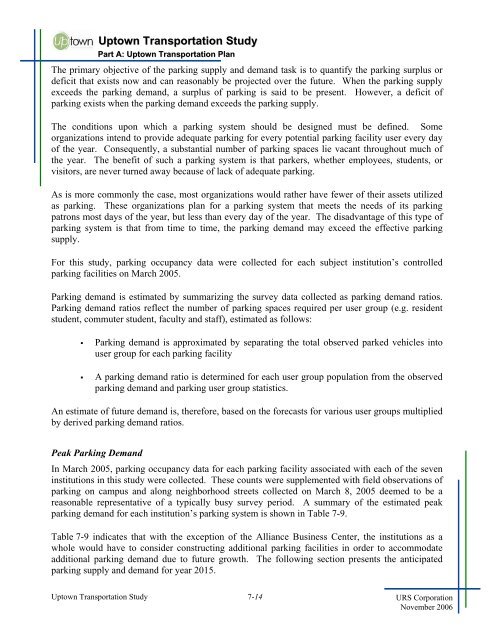Uptown Transportation Study CHAPTER 7: PARKING - OKI
Uptown Transportation Study CHAPTER 7: PARKING - OKI
Uptown Transportation Study CHAPTER 7: PARKING - OKI
Create successful ePaper yourself
Turn your PDF publications into a flip-book with our unique Google optimized e-Paper software.
<strong>Uptown</strong> <strong>Transportation</strong> <strong>Study</strong>Part A: <strong>Uptown</strong> <strong>Transportation</strong> PlanThe primary objective of the parking supply and demand task is to quantify the parking surplus ordeficit that exists now and can reasonably be projected over the future. When the parking supplyexceeds the parking demand, a surplus of parking is said to be present. However, a deficit ofparking exists when the parking demand exceeds the parking supply.The conditions upon which a parking system should be designed must be defined. Someorganizations intend to provide adequate parking for every potential parking facility user every dayof the year. Consequently, a substantial number of parking spaces lie vacant throughout much ofthe year. The benefit of such a parking system is that parkers, whether employees, students, orvisitors, are never turned away because of lack of adequate parking.As is more commonly the case, most organizations would rather have fewer of their assets utilizedas parking. These organizations plan for a parking system that meets the needs of its parkingpatrons most days of the year, but less than every day of the year. The disadvantage of this type ofparking system is that from time to time, the parking demand may exceed the effective parkingsupply.For this study, parking occupancy data were collected for each subject institution’s controlledparking facilities on March 2005.Parking demand is estimated by summarizing the survey data collected as parking demand ratios.Parking demand ratios reflect the number of parking spaces required per user group (e.g. residentstudent, commuter student, faculty and staff), estimated as follows:• Parking demand is approximated by separating the total observed parked vehicles intouser group for each parking facility• A parking demand ratio is determined for each user group population from the observedparking demand and parking user group statistics.An estimate of future demand is, therefore, based on the forecasts for various user groups multipliedby derived parking demand ratios.Peak Parking DemandIn March 2005, parking occupancy data for each parking facility associated with each of the seveninstitutions in this study were collected. These counts were supplemented with field observations ofparking on campus and along neighborhood streets collected on March 8, 2005 deemed to be areasonable representative of a typically busy survey period. A summary of the estimated peakparking demand for each institution’s parking system is shown in Table 7-9.Table 7-9 indicates that with the exception of the Alliance Business Center, the institutions as awhole would have to consider constructing additional parking facilities in order to accommodateadditional parking demand due to future growth. The following section presents the anticipatedparking supply and demand for year 2015.<strong>Uptown</strong> <strong>Transportation</strong> <strong>Study</strong> 7-14 URS CorporationNovember 2006
















